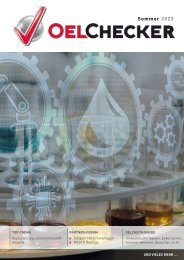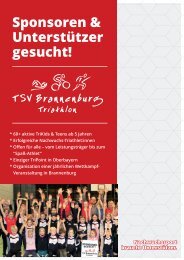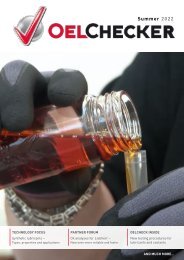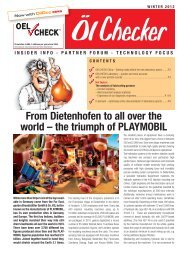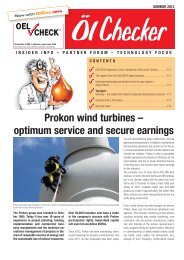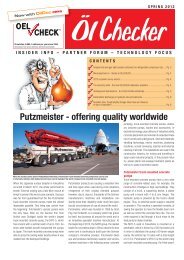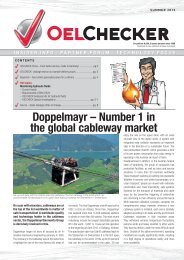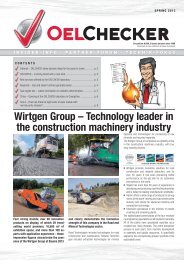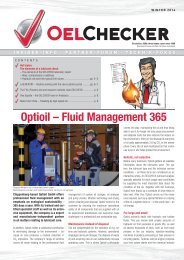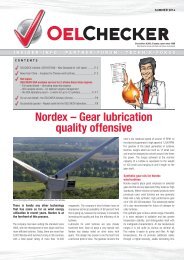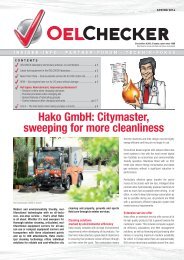OELCHECKER - Winter 2018
> Check-up – OELCHECK, a dream company > E-mobility – Our expertise is in demand > OELCHECK – Our all-inclusive analysis kits are now also available in Russia > China – Oil analyses for Anheuser-Busch InBev > A new building is on the way > New laboratory equipment at work – the FT-IR spectrometer > Technology Focus: Analysing lubricating greases > OELCHECK all-inclusive analysis kits for lubricating greases > Lubricating greases: their structure and function > Sampling made easy > Q&A: What is a refractive index, exactly?
> Check-up – OELCHECK, a dream company
> E-mobility – Our expertise is in demand
> OELCHECK – Our all-inclusive analysis kits are now also available in Russia
> China – Oil analyses for Anheuser-Busch InBev
> A new building is on the way
> New laboratory equipment at work – the FT-IR spectrometer
> Technology Focus: Analysing lubricating greases
> OELCHECK all-inclusive analysis kits for lubricating greases
> Lubricating greases: their structure and function
> Sampling made easy
> Q&A: What is a refractive index, exactly?
You also want an ePaper? Increase the reach of your titles
YUMPU automatically turns print PDFs into web optimized ePapers that Google loves.
<strong>Winter</strong> <strong>2018</strong><br />
INSIDER-INFO PARTNER-FORUM TECHNOLOGY FOCUS<br />
CONTENT<br />
■ ■ Check-up – OELCHECK, a dream company.......................................................................................... p. 2<br />
■■<br />
E-mobility – Our expertise is in demand............................................................................................... p. 3<br />
■■<br />
OELCHECK – Our all-inclusive analysis kits are now also available in Russia.......................................... p. 3<br />
■■<br />
China – Oil analyses for Anheuser-Busch InBev ................................................................................... p. 3<br />
■■<br />
A new building is on the way............................................................................................................... p. 3<br />
■■<br />
New laboratory equipment at work – the FT-IR spectrometer................................................................ p. 4<br />
■■<br />
Technology Focus: Analysing lubricating greases<br />
– OELCHECK all-inclusive analysis kits for lubricating greases<br />
– Lubricating greases: their structure and function<br />
– Sampling made easy..................................................................................................................... p. 4-7<br />
■■<br />
Q&A: What is a refractive index, exactly? ............................................................................................ p. 8<br />
ARBURG – Your competent partner<br />
for efficient injection moulding<br />
With networked machines, including peripherals, ARBURG is at the head of its sector when it comes to Industry 4.0<br />
and other peripherals, rounds out ARBURG‘s wide<br />
variety of modular machines.<br />
ARBURG puts manufacturing efficiency at the heart of<br />
everything it does, and does so with the entire value<br />
chain in mind. Its objective is to ensure that ARBURG‘s<br />
clients can manufacture their plastic products to the<br />
highest quality standards and at minimal unit costs,<br />
from individual parts to large-volume production.<br />
Whatever the injection moulding task at hand, AR-<br />
BURG has just the technology and the processes that<br />
their customer needs - in modular form and individually<br />
tailored. Its machines are manufactured exclusively<br />
at ARBURG‘s German main plant in Loßburg,<br />
Baden-Württemberg, where a first-class customer<br />
support experience is also provided on-site by AR-<br />
BURG‘s global sales and service network.<br />
Plastic is booming!<br />
A total of 348 million tons of plastic products<br />
were produced worldwide in 2017;<br />
that‘s a 3.8 percent increase on the previous<br />
year. And these products include far<br />
more than just plastic packaging. Among<br />
other things, plastics are also used to<br />
manufacture components for the automotive<br />
industry, electronic communication<br />
and entertainment devices, and medical<br />
equipment. When it comes to getting more<br />
out of plastics, the German mechanical engineering<br />
company ARBURG has the ideal<br />
solutions.<br />
One of the world‘s leading manufacturers of machines<br />
for processing plastics, ARBURG is also a<br />
pioneer in its sector, driving development in key<br />
areas such as production efficiency, Industry 4.0,<br />
and digitalization.<br />
The company‘s product range encompasses hydraulic,<br />
hybrid, and electric ALLROUNDER injection<br />
moulding machines with clamping forces between<br />
125 and 6,500 kN, while the Freeformer additive<br />
manufacturing system, together with robotic systems,<br />
client and sector-specific turnkey solutions<br />
Hydraulic oils to meet the highest<br />
requirements<br />
Hydraulic, hybrid, and electric ALL-ROUNDER injection<br />
moulding machines require high-quality<br />
hydraulic oils. In the case of smaller machines, the<br />
quantity of oil used is generally between 40 and 80<br />
litres, whereas mid-sized machines can use as many<br />
as 320 litres. The large hydraulic and hybrid ALL-<br />
ROUNDERS use between 400 and 800 litres of oil. In<br />
addition to lubricating, cooling and protecting pumps<br />
and moving components, the main task of hydraulic<br />
oils is power transfer, including provision of dynamic<br />
injection and retention forces. The clamping force
Check-up<br />
Nobody knows OELCHECK better than our employees. And it‘s<br />
their honest judgement of our company in the latest employee<br />
survey of October <strong>2018</strong> that we have to thank for making<br />
us winners of the DREAM COMPANY Award again, which we first<br />
brought home in 2009.<br />
This award recognizes companies which have distinguished themselves<br />
with an exceptionally employee-friendly and appreciative corporate<br />
culture. That OELCHECK meets this exacting requirement<br />
is amply demonstrated by what the people who work for us had to say.<br />
And as far as they‘re concerned, OELCHECK is a company that its employees are<br />
happy to recommend to others! Among other things, they appreciate our excellent<br />
teamwork culture, our ideally equipped workspaces (including air conditioning), and<br />
the ready availability of all of the resources they need to perform their jobs to the<br />
highest standard. The socially-minded attitude taken by our management is also<br />
reflected in the social benefits that we provide for our employees. Special emphasis<br />
is placed on promoting health in the workplace, for example, with a gym and fitness<br />
courses, a sauna, and a swimming pool available, together with unforgettable<br />
annual team events and an accident insurance policy for every employee that also covers non-occupational<br />
accidents.<br />
Thanks to the votes of our co-workers and the fulfilment of other criteria, OELCHECK will now enjoy<br />
the status of DREAM COMPANY for another two-year period. The results achieved by the company<br />
in the survey have improved consistently since its first edition in 2009, even while the number<br />
of people that we employ has doubled during this time. Meanwhile, we have achieved a fantastic<br />
overall score of 80% in the DREAM COMPANY Awards ranking. This is no coincidence, but instead<br />
impressive proof of just how much value we place on an employee-friendly and appreciative corporate<br />
culture. And this isn‘t just a matter of management either; our employees have their part to play as well.<br />
At the end of the day, it‘s both dream bosses and dream employees that OELCHECK has to thank for<br />
its success as a dream company!<br />
Yours, Barbara Weismann<br />
spectrum of ARBURG injection moulding machines<br />
ranges from 125 to 6,500 kN.<br />
For the ALLROUNDER models, HLP 46 fluids are<br />
the most commonly used, although HVLP 32 fluids<br />
are also used in individual cases. The majority of<br />
these are highly refined, mineral-oil based hydraulic<br />
oils with zinciferous additives, which give the oils EP<br />
characteristics. Partly or completely synthetic HVLP<br />
hydraulic oils or zinc-free fluids are also increasingly<br />
being used, however. Meanwhile in the food and<br />
pharmaceutical industries, physiologically harmless<br />
hydraulic oils with NSF-H1 registration or with kosher<br />
or halal certification are often used.<br />
ARBURG specifies hydraulic oils with the following<br />
characteristics:<br />
• Very good lubricity and high shear stability<br />
• Outstanding EP and anti-wear protection and<br />
good ageing characteristics<br />
• Very good air release time and minimal foam<br />
formation tendency<br />
• Excellent demulsifying capacity and water<br />
separation<br />
• High thermal resistance with low oxidation tendency<br />
• Extremely good seal compatibility<br />
• Good filterability, including a 1 µm filtration system<br />
• Partially synthetic or synthetic fluids with a high<br />
viscosity index, and mineral oil-based HVLP oils<br />
without long-chain VI improvers<br />
• Available worldwide, and always with the same<br />
level of performance.<br />
Whatever the country in which a mineral oil company produces<br />
its lubricants, the fluids used in ARBURG injection<br />
moulding machines must always be of a consistent quality.<br />
The same requirement is posed by many internationally<br />
active machine manufacturers. When it comes to selecting<br />
base oils, this factor has an enormous impact. Until the<br />
turn of the millennium, hydraulic oils were manufactured<br />
predominantly from class I and II paraffin-based base oils.<br />
Today, increasing use is made of class III hydrocrack oils,<br />
as well as class IV synthetic oils based on poly-alpha olefin<br />
(PAO). These base oils can be produced worldwide with<br />
identical characteristics, although often only with difficulty.<br />
They give the hydraulic oils not only better oxidation stability,<br />
but also and most importantly a significantly higher<br />
viscosity index, so the viscosity of the oils is less sensitive<br />
to temperature.<br />
In order to produce an HVLP oil with multigrade features<br />
from a mineral oil-based monograde HLP oil, special VI improvers<br />
must be added to the base oil. These consist mostly<br />
of long-chain hydrocarbon molecules, which contract at<br />
low temperatures and stretch at high ones. These are not<br />
shear-stable beyond a duration of use of over 10,000 operating<br />
hours, however, so their positive effect on the viscosity<br />
of the HVLP oils diminishes over the duration of use. This is<br />
why ARBURG specifies the use of mineral oil-based hydraulic<br />
fluids that do not contain any shear-sensitive VI improvers.<br />
Oil analyses are a part of maintenance<br />
For the operators of ARBURG injection moulding machines,<br />
OELCHECK lubricant analyses are an important part of<br />
monitoring oils and systems. An annual oil analysis is an<br />
integral component of the ALLROUNDER maintenance<br />
schedule. For even better monitoring, ARBURG recommends<br />
regular trend analyses at intervals of six months.<br />
This allows contamination and oxidation trends, as well as<br />
possible component failures, to be identified at an early<br />
stage. In the event that sources of errors are discovered,<br />
machine availability can be increased with preventative<br />
maintenance. In the case of large and heavily utilised<br />
machines, many operators use synthetic-based hydraulic<br />
fluids in addition to running trend analyses for condition-based<br />
oil changes. Based on OELCHECK lab reports<br />
and in consultation with ARBURG, oil change intervals of<br />
20,000 operating hours can in many cases be extended,<br />
thereby significantly reducing expenditure on costly synthetic<br />
oils.<br />
Analysis kits are always to hand<br />
Most oil samples are taken by the plant operators. In order<br />
to be able to react quickly on-site and take oil samples at<br />
short notice, however, every ARBURG service engineer<br />
always has their own OELCHECK all-inclusive analysis<br />
kits to hand. If, for example, filters need to be changed<br />
unusually often, the oil shows increased foam formation,<br />
or there are doubts about the type of oil used or its quality,<br />
then these analyses can provide useful information. They<br />
help service engineers to quickly determine the causes<br />
and take appropriate action without delay.<br />
2<br />
Further information: www.arburg.com
OELCHECK INSIDER INFO<br />
E-mobility: Our expertise is in demand<br />
OELCHECK analysis kits: now also in Cyrillic<br />
Since 1 November <strong>2018</strong>,<br />
LUBESERV has been acting<br />
as an agent for marketing<br />
OELCHECK analysis kits in Russia, whilst also providing<br />
consultation on analysis-related questions.<br />
Following the current induction and training phase<br />
that will be completed by the end of January 2019,<br />
sales in Russia will be launched on an official basis.<br />
Our contact partners for Russia and China will be<br />
waiting to meet you in person at OELCHECK‘s booth<br />
at the OilDoc Conference in Rosenheim.<br />
From 1 February 2019, processing and dispatch<br />
of lubricant samples from Russia and the CIS will<br />
be handled smoothly and conveniently by Lubeserv,<br />
which has its headquarters in Yekaterinburg. As<br />
Working together – winning together<br />
Leading global brewery has its oils from China checked at OELCHECK<br />
We have recently gained a<br />
major new customer in China:<br />
the breweries of Anheuser-Busch<br />
InBev. AB InBev is<br />
the largest brewery group in<br />
the world in terms of beer sales,<br />
and is also market leader in<br />
China where it has more than 40 breweries.<br />
In China and many other countries, the company is<br />
best known for the US beer brand Budweiser. This<br />
is not its only big-name beer, however, with major<br />
German brands like Beck‘s also part of the group‘s<br />
product range.<br />
The company anticipates that oil analyses from<br />
OELCHECK will help to optimize oil change intervals<br />
With the number of employees and samples on<br />
the OELCHECK premises constantly on the grow,<br />
things are starting to get a little bit cramped.<br />
That‘s why in 2019 we‘ll be building a brand new<br />
building that reflects our aspirations, including<br />
modern office and meeting spaces as well as a<br />
large cafeteria.<br />
Our colleagues Dr Thomas Fischer, Head of Scientific<br />
Research, and Arne Simon (MSc Chemical and<br />
Process Engineering), tribologist, are participating<br />
in a new DIN committee dedicated to the electrical<br />
characteristics of oils.<br />
The committee is concerned with the electrical<br />
characteristics of oils in relation to e-mobility.<br />
Oils used in this sector must provide both lubrication<br />
and insulation, which is why the committee<br />
has the objective of identifying suitable methods<br />
for measuring the electrical characteristics of oils,<br />
with our exclusive agent in China, examination of the<br />
samples and diagnosis based on the lab results will<br />
naturally be carried out by our colleagues in Brannenburg.<br />
Our Russian customers will then receive<br />
their lab reports in the usual format, but in their<br />
native language and printed in the Cyrillic alphabet.<br />
Sales of the analysis kits in Russia and transportation<br />
of the samples to Brannenburg will be handled<br />
by LUBESERV. The close cooperation established<br />
between OELCHECK and LUBESERV means that we<br />
can guarantee our Russian customers, as well as<br />
German machine manufacturers who require analysis<br />
data from this region, a smooth process for their<br />
lubricant and operating fluid analyses.<br />
for its production and bottling machines. The majority<br />
of the chiller, gear, and hydraulic oils used by<br />
the company are presently changed once per year.<br />
Adapting to condition-dependent oil changes based<br />
on oil analyses offers enormous potential savings in<br />
this respect. The analyses should also permit better,<br />
more proactive early detection of damage, thereby<br />
helping to avoid unplanned downtime. Due to the full<br />
utilization of the Chinese breweries, every minute of<br />
unplanned downtime results in enormous costs and<br />
production losses.<br />
AB InBev is entrusting the oil analyses for its refrigeration<br />
and CO 2<br />
compressors, hydraulic presses, bottling<br />
plants, and mixer drives to our laboratory in Brannenburg.<br />
As is the case for all companies in China,<br />
A new building is on the way<br />
To make room for the new building, the car park<br />
presently located next to our head office at Kerschelweg<br />
28 will have to go. The resulting proximity<br />
of the three buildings will ensure close and<br />
ideal cooperation between all of our departments.<br />
A new car park for 90 vehicles located close to our<br />
company buildings is already in the final stages<br />
including conductivity, permittivity, breakdown<br />
voltage, and dielectric dissipation factor.<br />
Examining these electrical characteristics will reveal<br />
which oils are suitable for use, and will furthermore<br />
make it possible to monitor the ageing and alteration<br />
of oils.<br />
As participants in this DIN committee, our<br />
OELCHECK colleagues are contributing their many<br />
years of expertise in lubricant and operating fluid<br />
analysis to the task at hand.<br />
Contract signing with (from left to right) Paul Weismann<br />
(OELCHECK Managing Director), Oxana Gernlayn (LubeServ)<br />
and Steffen Bots (LubeServ)<br />
Do you need to have samples from Russia or<br />
the CIS analysed?<br />
Get in touch with us by phone on +49-8034-9047-250, or by<br />
email at sales@oelcheck.de.<br />
samples will be handled by OELCHECK‘s exclusive<br />
agent LUBECHECK CHINA, where Julie Qiu and her<br />
team not only sell our all-inclusive analysis kits, but<br />
also provide on-site support for questions relating to<br />
sampling and kit selection. They even translate the<br />
Chinese questions on the information forms and the<br />
diagnoses in the lab reports, and provide perfect allround<br />
service that many customers in China have<br />
already come to value.<br />
of construction, and will<br />
be finished before the<br />
end of <strong>2018</strong>.<br />
3
OELCHECK TECHNOLOGY FOCUS<br />
Small sample, big benefit!<br />
All-inclusive lubricating grease analysis by OELCHECK<br />
Rolling and glide bearings, constant-velocity joints and open chainwheel drives generally<br />
have one thing in common: they are lubricated with grease. This applies in particular to<br />
more than 80% of rolling bearings, which are available in many different forms. Lubricating<br />
grease is involved in 75% of bearing failure incidents. For example, the grease may<br />
be contaminated, bled out, oxidised or aged, burdened with wear particles, or simply not<br />
present in an adequate amount. The good news is that if you use OELCHECK lubricating<br />
grease analyses to stay informed of the condition of the lubricating grease concerned,<br />
you can take countermeasures promptly and avoid failures.<br />
Over 10% of the samples processed every day<br />
by OELCHECK (as many as 2,000) involve lubricating<br />
greases – which must be assessed just<br />
as thoroughly and reliably as oils, coolants and<br />
fuels. However, lubricating grease analysis is not<br />
straightforward due to the small sample volumes,<br />
and only a few labs worldwide are able to do this.<br />
One of them is OELCHECK. We have laboratory<br />
equipment that has been adapted to our wishes,<br />
as well as many years of experience in the assessment<br />
of grease samples.<br />
Your ace for bearing lubrication:<br />
OELCHECK lubricating grease analyses<br />
• Detect bearing wear and its causes at an early<br />
stage<br />
• Distinguish between mechanical and corrosion<br />
wear<br />
• Timely warning of lubricant oxidation and ageing<br />
• Identify contaminants and their origins<br />
• Detect mixing with other greases<br />
• Helps with the optimisation of lubricant amounts<br />
and relubrication intervals<br />
Lubricating grease analyses from OELCHECK<br />
make a major contribution to operational reliability<br />
and have a positive impact on maintenance<br />
costs.<br />
All-inclusive analysis kits: for all applications<br />
and all issues<br />
The handy OELCHECK all-inclusive analysis kits are<br />
a good choice for testing lubricating greases. However,<br />
the values provided by the test parameters in<br />
kits 1 and 2 are only suitable for trend analyses<br />
and assessment of fresh greases. For analysis of<br />
used grease with kits 3, 4 or 5, additional tests<br />
are performed to enable OELCHECK tribologists to<br />
make a comprehensive assessment. All-inclusive<br />
analysis kits 3 and 5 are specifically matched to<br />
the corresponding applications and issues. Our<br />
OELCHECK tribologists will be pleased to answer<br />
your questions about choosing the right analysis kit<br />
Kit 1: The elements<br />
The start of every analysis<br />
After visual evaluation and photography<br />
of the lid, the sampling tube and<br />
the sample bottle, we determine more<br />
than 20 elements for every lubricating grease sample.<br />
Along with wear and contamination particles,<br />
we examine the active ingredients and additives<br />
already present in the fresh grease. Using atomic<br />
emission spectroscopy (AES) with the rotating<br />
disc electrode method, in which a small amount<br />
of grease is applied to a target turntable, up to 21<br />
elements are determined quantitatively and stated<br />
in the lab report in units of mg/kg (ppm). These<br />
values are divided into three categories: wear elements,<br />
contaminants and additives.<br />
• Typical wear elements<br />
Iron, chromium, tin, copper, lead, nickel, aluminium,<br />
molybdenum and zinc, as well as concentrations<br />
of vanadium, titanium, silver, antimony,<br />
manganese and tungsten. Elevated iron and<br />
chromium values, for example, indicate wear of<br />
a rolling bearing. Copper and zinc indicate wear<br />
of a brass bearing cage.<br />
• Typical contaminants<br />
Silicon, calcium, sodium, potassium, aluminium,<br />
cadmium and bismuth. Silicon (dust) and<br />
calcium (lime) in particular, as deposits from<br />
hard water, can promote wear. Sodium can also<br />
come from salt water and cause corrosion wear.<br />
4<br />
New equipment deployed<br />
We have equipped our laboratory with two new<br />
FT-IR spectrometers, each with an autosampler.<br />
Each of these instruments can examine 480 samples<br />
in sequence. That allows 960 samples to be<br />
analysed in one night by these two devices alone.<br />
OELCHECK is already well equipped for further<br />
growth in the number of samples. With this new<br />
equipment set-up, we are again a pioneer because<br />
it has not yet been deployed in any other lab for<br />
lubricants and operating fluids. During the development<br />
process, we worked closely with the suppliers<br />
Axel Semrau GmbH & Co. KG for the autosamplers<br />
and Thermo Fisher Scientific GmbH for the FT-IR<br />
spectrometers. As a result, the instrument system<br />
is precisely tailored to our needs and makes the<br />
work easier for our staff.<br />
We have additionally equipped our laboratory with<br />
another ICP-OES spectrometer. That means we<br />
now have five instruments available for the vital<br />
element analysis.
• Typical additives and thickeners<br />
Lithium, magnesium, calcium, phosphorus, zinc,<br />
barium, silicon, aluminium, molybdenum and<br />
boron. Their values are compared to those of<br />
the fresh grease. A change relative to a previous<br />
sample or the fresh grease can indicate mixing<br />
or reduced grease performance.<br />
Kit 2: Kit 1 + iron particles and base oil<br />
modification<br />
The basis for further assessment<br />
In addition to the element values in<br />
kit 1, OELCHECK includes the Particle<br />
Quantifier (PQ) index in the scope<br />
of all-inclusive analysis kit 2 to identify even the<br />
smallest iron particles that can still be magnetised.<br />
AES is not able to stimulate particles larger than<br />
2 µm strongly enough for reproducible indication.<br />
By contrast, the PQ index includes all particles<br />
present in the grease that are able to react to a<br />
magnetic field. Our OELCHECK tribologists know<br />
the relationships between the determined iron content<br />
in ppm and the PQ index and are able to make<br />
clear statements regarding the condition of the<br />
bearing concerned.<br />
• For example, a high iron value with a relatively<br />
low PQ index is a sign of corrosion. Rust particles<br />
are barely magnetic, but they are so small<br />
that they can be measured with AES.<br />
• A high PQ index together with a low AES value is<br />
a sign of contamination or material fatigue.<br />
Furthermore, in kit 2 and above the base oil type<br />
and its modification by water or temperature is<br />
determined using FT-IR spectroscopy. The base<br />
oil is usually the main ingredient of a lubricating<br />
grease, with a share of more than 80%. The thermal<br />
characteristics and oxidation resistance of the<br />
base oil are decisive for the working temperature<br />
range of the grease, and in part for its ageing<br />
characteristics.<br />
Fourier transform infrared (FT-IR) spectroscopy is<br />
based on the fact that the molecules in a grease<br />
absorb infrared light at specific wavelengths to different<br />
degrees due to their typical bond types. The<br />
Fourier transform makes the values readable, and<br />
the molecular vibrations can be shown in an FT-IR<br />
diagram. This produces peaks at relevant wave<br />
numbers, depending on the molecular bond. The<br />
deviations of the peaks at specific wave numbers<br />
can be recognised by comparing the FT-IR diagram<br />
of a used grease with the diagram of the fresh version<br />
of the same grease. Our OELCHECK tribologists<br />
can draw clear conclusions from this. FT-IR spectroscopy<br />
gives them the following indications:<br />
• Whether the examined grease contains a mineral<br />
or synthetic base oil<br />
• Whether a different type of grease than expected<br />
has been used<br />
• If greases have been mixed or the wrong grease<br />
was used for relubrication<br />
• Potential additive deterioration if the grease contains<br />
high-pressure additives, for example based<br />
on zinc phosphate compounds<br />
• Any water penetration greater than 1%<br />
• Whether a mineral oil-based grease has been<br />
oxidised and aged due to exposure to high temperature<br />
or lack of relubrication<br />
However, when ester-based components are used,<br />
FT-IR spectroscopy cannot provide unambiguous<br />
information about their oxidation because the oxygen<br />
molecules present in the ester absorb infrared<br />
light in the same wave number region as the<br />
oxygen double bonds resulting from oxidation. In<br />
this case FT-IR spectroscopy meets its limits. As<br />
an alternative, a RULER test in an OELCHECK lab<br />
indicates whether the grease concerned has been<br />
overheated.<br />
Kit 3: Kit 2 + quantitative water content<br />
Against corrosion and rust<br />
If too much water penetrates into a<br />
lubricating grease, more frequent relubrication<br />
is necessary. However, that<br />
is the least of the problems. If the grease cannot<br />
withstand the water, the soap structure changes<br />
and the grease becomes weak and soupy. In many<br />
cases the seals cannot contain the grease and it<br />
leaks out. If a grease is burdened with too much<br />
water, there is a risk of rust and corrosion, leading<br />
to bearing damage. On lubricating surfaces with<br />
high relative motion, water-induced cavitation often<br />
occurs.<br />
All-inclusive lubricating grease kits 3 to 5 include<br />
determination of the exact water content in ppm<br />
using titration according to the elaborate Karl Fischer<br />
method. Too much water in the grease (more than<br />
150 ppm) can have serious consequences.<br />
In the Karl Fischer method, a small amount of<br />
grease is weighed into a tube that can be hermetically<br />
closed. The water is then slowly driven out of<br />
the grease in a lab oven at a temperature of 120 °C.<br />
The evaporated water, together with nitrogen, is fed<br />
through a hollow needle to a titration tube. There<br />
it reacts electrochemically with a specific solution.<br />
The water content of the grease in ppm (mg/kg)<br />
can be read precisely from the inflection point of<br />
the titration curve.<br />
When assessing the analysis results, the<br />
OELCHECK tribologists also consider the relationship<br />
between the water content and the element<br />
values determined by AES. From that they can<br />
often see whether the water came from condensation,<br />
rain, tap water or salt water. This makes<br />
it easier for the customer on site to stop the water<br />
penetration. If the grease is contaminated with calcium,<br />
potassium, sodium and/or magnesium, that<br />
is usually a sign of hard tap water. In many cases,<br />
water has penetrated from high-pressure cleaning.<br />
If the above-mentioned elements are only present<br />
in low concentrations in the used grease, that is<br />
usually a sign of ‚soft‘ condensation or rainwater. If<br />
the sodium share clearly predominates, the water<br />
is probably salt water.<br />
Kit 4: Kit 3 + residual oil content & bleeding test<br />
Against loss of lubrication performance<br />
As you might guess, bleeding out is<br />
not a good situation for a lubricating<br />
grease. When a grease bleeds out, it<br />
loses a considerable part of the base oil necessary<br />
for lubrication. If there is not enough oil present in<br />
a used grease, the impact can be dramatic. In the<br />
production of a lubricating grease, a boiled thickening<br />
agent, called the soap, is added to a base oil.<br />
The thickener holds the base oil in its sponge-like<br />
structure and slowly releases the oil to the lubricating<br />
surface. „Bleeding out“ means that the oil flows<br />
too quickly and uncontrollably from the thickener<br />
structure. The grease dries out and can no longer<br />
perform its lubrication tasks. In many practical<br />
cases, excessive loss of base oil from a grease<br />
is initially only noticeable from strong oil fouling of<br />
the seal area and a need for more frequent relubrication.<br />
In such cases an immediate examination of<br />
the grease using OELCHECK all-inclusive kit 4 is<br />
recommended. In addition to the analysis methods<br />
in kits 1 to 3, it includes determination of the residual<br />
oil content.<br />
5
OELCHECK TECHNOLOGY FOCUS<br />
6<br />
For that purpose, the grease sample is heated to<br />
60˚C in the OELCHECK lab and held at that temperature<br />
for six hours. The percentage of the base<br />
oil lost from the thickener structure during this period<br />
is then determined. After that, the value for the<br />
used grease is compared to the value for the fresh<br />
grease. The following conclusions can usually be<br />
drawn from the results:<br />
• Base oil loss between 5 and 25%:<br />
The grease can continue to be used without any<br />
change to the relubrication interval.<br />
• Base oil loss significantly higher than 25%<br />
The grease is no longer suitable for use. To<br />
avoid damage, the causes must be determined<br />
promptly.<br />
• Due to high shaft speeds, loads or vibrations,<br />
the grease is simply unsuitable and its working<br />
temperature range is too low.<br />
• There have been errors in handling. The relubrication<br />
amount was too small. Incompatible<br />
greases were mixed. The grease was used for<br />
too long or not relubricated. In that case, the<br />
base oil is usually also oxidised or aged.<br />
• The grease is contaminated with water, acids<br />
or alkalis.<br />
• Base oil loss less than 5%:<br />
If very little base oil escapes from the used<br />
grease, that is also not a good sign. In many<br />
cases, the grease has already been bled nearly<br />
dry. The bearing surface is starved of lubrication.<br />
Relubrication as quickly as possible is therefore<br />
necessary, or the relubrication interval must<br />
be shortened. It should also be checked if the<br />
grease that is being used is basically suitable<br />
for the task.<br />
Lubricating greases are commonly used in situations<br />
where a lubricating surface cannot be perfectly<br />
supplied with oil. In addition to providing optimal<br />
lubrication, in many cases lubricating greases must<br />
also seal lubricating surfaces and protect moving<br />
parts against wear and contamination. They should<br />
attenuate shock loads, and ideally they should be<br />
Kit 5: Kit 4 + penetration number:<br />
For a comprehensive assessment<br />
With all-inclusive lubricating grease<br />
kit 5, the OELCHECK tribologists can<br />
comprehensively describe the condition<br />
of the grease and the lubricated component. Kit 5 is<br />
based on the tests of the previous kits, augmented<br />
by determination of the consistency by means of the<br />
penetration number. The consistency number expresses<br />
the relative stiffness of lubricating greases.<br />
Lubricating greases are assigned to nine consistency<br />
classes according to the classification system<br />
of the US National Lubricating and Grease Institute<br />
(NLGI). This makes it easy to see, for example, if<br />
a grease can be easily pumped through a central<br />
lubrication system.<br />
However, the grease consistency can change<br />
during use. If it becomes significantly stiffer or<br />
softer, there is a risk to the component lubricated<br />
by the grease. That‘s why determination of the<br />
penetration number, and with it the consistency, is<br />
included in the scope of OELCHECK all-inclusive<br />
analysis kit 5.<br />
NLGIclasses<br />
Penetration<br />
numbers<br />
Consistency at<br />
room temperature<br />
000 445–475 Very liquid<br />
00 400–430 Liquid<br />
0 355–385 Semi-liquid<br />
1 310–340 Very soft<br />
2 265–295 Soft<br />
3 220–250 Semi-solid<br />
4 175–205 Solid<br />
5 130–160 Very solid<br />
6 85–115 Extremely solid<br />
NLGI classes: Penetration numbers and consistency<br />
suitable for lifetime lubrication. However, there are<br />
limits to what greases can do. Unlike liquid oils,<br />
they are not able to dissipate high temperatures or<br />
remove contaminants and wear particles from the<br />
friction surface.<br />
Lubricating greases are manufactured by stirring<br />
a liquid base oil into a suitable thickener. Additives,<br />
and in some cases solid lubricants, are mixed in<br />
to reduce friction and provide wear protection. Lubricating<br />
greases contain 70 to 95% base oil, 3 to<br />
30% thickener, 0 to 10% additives, and at most<br />
10% solid lubricants. As the main ingredient of a<br />
grease, the base oil essentially determines its lubricating<br />
and performance properties. Mineral oils,<br />
synthetic oils, and in some cases vegetable oils are<br />
used as base oils.<br />
Cone penetration - cone above grease and after 5 minutes<br />
The penetration number is determined by pressing a<br />
standardised cone into a specific amount of grease.<br />
At the start of the test, the tip of the cone is just<br />
touching the surface of the grease. The cone then<br />
penetrates deeper. Its penetration depth after five<br />
seconds is measured in units of 0.1 mm. That gives<br />
the penetration number, which in turn determines<br />
the consistency class of the grease. The softer the<br />
grease, the deeper the cone penetrates. The penetration<br />
number is high, and the NLGI class is low.<br />
OELCHECK compares the consistency classes or<br />
penetration numbers of the used grease and the<br />
corresponding fresh grease. That leads to the following<br />
conclusions:<br />
• Higher penetration number =<br />
Softer consistency, lower NLGI class:<br />
• The grease may be contaminated with water<br />
or another liquid.<br />
• Mixing with a grease that has a different<br />
thickener or base oil type.<br />
• The grease has been exposed to high loads<br />
and mechanically sheared.<br />
• Lower penetration number =<br />
Stiffer consistency, higher NLGI class:<br />
• The grease has become stiffer due to a lack<br />
of relubrication or bleeding.<br />
• Excessive loading by vibrations and/or working<br />
temperature range too high.<br />
• The pumping pressure of the central lubrication<br />
system is too high; the pipe cross section is<br />
too small.<br />
Brief: Lubricating greases<br />
Thickeners are divided into metallic soaps (such<br />
as lithium, sodium, calcium, barium or aluminium)<br />
and non-metallic soaps (such as bentonite, polymer<br />
resin or silica gel). As carriers for the base oil, they<br />
form a cross-linked, sponge-like structure. This<br />
structure holds the oil and releases it to the lubricating<br />
surface in a controlled manner.<br />
Certain properties of a lubricating grease can be<br />
strengthened and/or specifically modified by additives.<br />
If a grease has to work under especially severe<br />
conditions or have emergency running properties,<br />
solid lubricants such as graphite, molybdenum<br />
disulphide (MoS 2<br />
) or PTFE (Teflon) are additionally<br />
mixed in. A grease containing more than 40% solid<br />
lubricants is called a paste.
Lubricating greases<br />
Making sampling easy<br />
With the all-inclusive analysis kits from<br />
OELCHECK and our basic equipment, you<br />
are perfectly equipped for properly taking<br />
reference samples of used lubricating<br />
greases.<br />
The basic equipment<br />
Taking samples of lubricating greases is a bit more<br />
complicated than taking samples of liquids.<br />
However, the low-cost OELCHECK Grease Sampling<br />
Kit (Z-3) considerably simplifies this task<br />
and should be part of your basic equipment.<br />
It contains a syringe and a 20-cm tube, which can<br />
also be reordered in bulk. There are also three<br />
spatulas with different sizes for taking samples of<br />
grease located between the bearing and the seal<br />
or in the bearing cage, and a cloth for cleaning the<br />
used spatulas.<br />
An all-inclusive analysis kit for lubricating<br />
greases from OELCHECK<br />
Each prepaid OELCHECK all-inclusive analysis kit<br />
for lubricating greases contains:<br />
• A transparent sample bottle with a lid in the kit colour<br />
• A transparent tube for the syringe of the grease<br />
sampling kit (Z-3)<br />
• A specific Sample Information Form with a<br />
self-adhesive lab number for labelling the<br />
sample bottle<br />
• A pre-addressed, leak-tight return envelope<br />
• A UPS return voucher for free shipping to our<br />
laboratory<br />
Determination of more than 20 analysis values and<br />
interpretation of these values by an OELCHECK<br />
tribologist are also included in the kit price. The<br />
clearly formulated lab report with images and individual<br />
values is usually sent by post or e-mail on<br />
the second working day after receipt of the sample.<br />
It can also be retrieved at any time from www.lab.<br />
report.<br />
Important: Only properly taken samples<br />
provide valid results.<br />
• Make sure that as much as possible, no fresh<br />
grease is included when you take the sample.<br />
The sample should come from the area where<br />
the grease does its work. You should therefore<br />
visually check, based on the change in colour<br />
or structure, that you have actually sampled<br />
used grease. Conclusions regarding the condition<br />
of the components lubricated by the grease<br />
are only possible with analysis values from used<br />
grease.<br />
• Please ensure that the sampling aids are clean.<br />
Before taking the sample, clean the area around<br />
the grease sampling point. Avoid contamination<br />
of the sample by dust, water or deposited seal<br />
particles.<br />
• For trend analyses, always take the samples<br />
from a specific point using the same sampling<br />
procedure.<br />
• You should preferably use the aids in the<br />
OELCHECK Grease Sampling Kit. Metal<br />
particles from a screwdriver or particles from a<br />
wooden spatula can corrupt analysis values.<br />
• Never mix grease samples in the same<br />
sample bottle, even if they come from the<br />
same component but from different lubricating<br />
surfaces.<br />
• If you are not sure that we already have the<br />
grease in our database, please also send a<br />
sample of the fresh grease with your first<br />
sample of used grease for analysis, for use as<br />
a reference.<br />
Even small amounts of lubricant are sufficient.<br />
OELCHECK needs only relatively small amounts of<br />
grease for analysis of lubricating greases.<br />
For example, only about 3 g of grease is needed for<br />
the determination of more than 30 individual values<br />
with all-inclusive analysis kit 3. That corresponds to<br />
3 cm of grease in the tube, a bit less than a teaspoon.<br />
Spatula or syringe?<br />
With samples from large rolling bearings, fresh<br />
grease containers or relatively open grease sampling<br />
points, the grease can usually be sucked<br />
directly into the tube with the vacuum syringe.<br />
With less accessible components or narrow lubrication<br />
gaps, which are often also close to the seal,<br />
you will usually need to use one of the spatulas<br />
from the sampling kit.<br />
Grease sampling with the<br />
syringe<br />
• Fit the tube on the conical tip of<br />
the syringe.<br />
• Suck up the used grease into the<br />
tube opening. Depending on the<br />
type of construction, select:<br />
- A drilled grease sampling hole<br />
closed by a screw<br />
- An inspection opening<br />
- A removed grease nipple or<br />
the connector for the central<br />
lubrication line<br />
• Using the syringe, suck the required amount<br />
of lubricating grease into the tube. Do not<br />
allow the grease to contact the syringe. That is<br />
essential so that you can reuse the syringe.<br />
• Avoid sucking too much air in the grease sample.<br />
• Pull off the tube, fold it in the middle, and place<br />
it in the sample bottle with the fold facing up.<br />
That makes it easy to remove in the lab.<br />
In the case of dismantled rolling bearings, you should<br />
suck the used grease into the tube from the cage<br />
area and between the rolling elements. With relatively<br />
small bearings it is better to use a spatula.<br />
With large rolling-contact bearings (over 1,000 mm),<br />
take the grease from the sampling bores provided for<br />
that purpose. The sampling points should be close to<br />
the bearing races in the main load-bearing area.<br />
Sampling with a spatula<br />
• Mix the grease with the spatula or<br />
by slow rotation, in order to obtain<br />
a representative sample amount.<br />
• As much as possible, the grease<br />
sample should be taken from<br />
the following places: the running<br />
surfaces, the web of the bearing<br />
cage, or from both sides of the<br />
bearing balls or rollers.<br />
• Scrape the grease from the<br />
spatula into the lid of the sample<br />
bottle or somewhere in the sample bottle, and<br />
then securely close the sample bottle.<br />
7
8<br />
OELCHECK checks not only our gas engine<br />
oils, but also coolants from these engines.<br />
The lab reports for coolants now also include<br />
the refractive index at 20 °C. How is<br />
this value determined? What does it mean<br />
if this has changed? And is a refractive<br />
index relevant for oils as well?<br />
OELCHECK:<br />
Every fluid has a characteristic refractive index.<br />
Its interpretation relates to the concentration of<br />
specific substances in the fluid. Coolants consist<br />
mostly of water mixed with ethylene glycol or propylene<br />
glycol. The refractive index can be used to<br />
determine the percentage of glycol in the coolant.<br />
As different types of base oil also vary in terms of<br />
their refractive index, this value is also helpful for<br />
identifying mixtures of different oil types, among<br />
other things.<br />
Refraction of light<br />
The refractive index has its origins in optics. When<br />
light passes from one medium into another, the<br />
rays of light are refracted at the junction, changing<br />
their direction and their speed. Figuratively<br />
speaking, the ray of light bends. The strength of<br />
the effect depends on the refractive index of the<br />
medium.<br />
Determining refractive indices with a<br />
hand refractometer<br />
The easiest way to determine refractive indices is<br />
by using a hand refractometer. This device measures<br />
the behaviour of light at the junction between<br />
a prism and the material being tested.<br />
Q&A<br />
<strong>Winter</strong> <strong>2018</strong><br />
A typical application is measuring the sugar<br />
content of grape must, which is a criterion in<br />
determining the quality of wine. Particularly in<br />
the case of foodstuffs, the refractive index is still<br />
traditionally given in °Brix, or in the case of wine<br />
in °Oechsle.<br />
In metalworking, hand refractometers are an essential<br />
tool for monitoring the concentration of<br />
oil-in-water emulsions. Refractometers can also<br />
be very helpful when a mixture of incompatible<br />
oils needs to be checked.<br />
Exact values can only be determined in<br />
the lab<br />
Due to the different wavelengths of light, using a<br />
hand refractometer is not the most accurate way<br />
of determining refractive indices. The value varies<br />
slightly at these different wavelengths, and is also<br />
affected by the light source and temperature. Even<br />
the human eye perceives colours slightly differently<br />
depending on differences in wavelength. In<br />
order to exclude deviations and to make values truly<br />
comparable, a specific wavelength that can only<br />
be produced under laboratory conditions has been<br />
defined for the determination of refractive indices.<br />
Sodium D line light is produced when table salt<br />
is burned in a gas flame, It consists of the wavelengths<br />
588.9951 nm and 589.5924 nm. In our<br />
lab reports for coolant fluids, we state the refractive<br />
index determined at this wavelength at a media<br />
temperature of 20 °C.<br />
The higher the refractive index of a medium, the<br />
more strongly the light refracts. By way of illustration,<br />
a vacuum has a refractive index of 1.0, the<br />
refractive index of air (1013 mbar) is 1.000272,<br />
and drinking water has a refractive index of 1.333.<br />
Ethylene glycol, which is used to prepare coolants,<br />
has an index of 1.43.<br />
When a refractive index is needed to indicate<br />
a relatively exact quantitative share of glycol in<br />
water, it is therefore better to have this determined<br />
in a laboratory.<br />
Refractive indices of coolants and oils<br />
OELCHECK measures refractive indices using the<br />
RX40 Refractive Index Cell Module from Mettler<br />
Toledo. This produces the wavelengths of light<br />
required with high accuracy, and determines refractive<br />
indices within a value range of 1.3200 to<br />
IMPRINT<br />
OelChecker – an OELCHECK magazine<br />
Kerschelweg 28 · 83098 Brannenburg · Germany<br />
info@oelcheck.de · www.oelcheck.de<br />
All rights reserved Reproduction is only permitted after<br />
receiving our approval.<br />
Concept and text:<br />
OELCHECK GmbH · Astrid Hackländer<br />
Layout and design:<br />
Agentur Segel Setzen, Petra Bots, www.segel-setzen.com<br />
Photos:<br />
OELCHECK · ARBURG · istockPhoto · Mettler Toledo · Wikimedia<br />
1.7000. The refractive index can then be used to<br />
determine the mixing ratio of two components.<br />
In the case of coolants, the concentration<br />
and quantity of ethylene glycol or propylene glycol<br />
mixed into the water are determined. This is<br />
important information, because the glycol content<br />
affects the thermal characteristics of the coolant.<br />
Concentrations of inhibitors, which give the water<br />
additional protection against corrosion, can also<br />
be determined in this way. As it is difficult to identify<br />
exact proportions of ethylene and propylene<br />
glycol using the refractive index alone, OELCHECK<br />
also determines the density of the coolant mixture.<br />
Comparison of these values then makes it possible<br />
to make a clear assessment.<br />
In the case of base oils of varying origins and<br />
compositions, refractive indices enable us to get<br />
to the bottom of what mixtures contain. In order to<br />
do this, we generally measure not only refractive<br />
index, but also density, viscosity index, and IR<br />
spectrum.<br />
The values for hydrocarbons (mineral or synthetic),<br />
esters, and glycols vary less than they do in<br />
the case of water-glycol mixtures. For silicone<br />
or perfluorinated polyether (PFPR) based oils, on<br />
the other hand, there are clearly distinctive values.<br />
Particularly with mixtures involving silicones and<br />
PFPEs, which are not compatible with other lubricants,<br />
the consequences can be very severe.<br />
Silicone oils, such as those used in some non-water<br />
miscible metalworking fluids or as insulating<br />
oils in transformers, must remain entirely free<br />
from other types of oil. PFPE-based lubricants,<br />
which have an exceptional performance capacity<br />
at high temperatures and are resistant to chemicals,<br />
must likewise not be contaminated with<br />
other lubricants.<br />
Determining their refractive indices in the laboratory<br />
allows mixtures that are hazardous with<br />
regard to these products to be easily identified.<br />
OELCHECK is ready to answer any questions you may have about tribology or lubricant analysis.<br />
Contact us by email (info@oelcheck.de) or by fax (+49 8034 9047 47).




